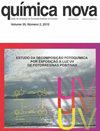ESTUDO DE COMPOSTOS POLIAROMÁTICOS NÃO CONVENCIONAIS E MERCÚRIO NA BAÍA DE TODOS OS SANTOS, BRASIL: AVANÇOS RECENTES E CONTRIBUIÇÃO PARA MELHOR COMPREENSÃO DO AMBIENTE MARINHO
IF 0.7
4区 化学
Q4 CHEMISTRY, MULTIDISCIPLINARY
引用次数: 1
Abstract
UNCONVENTIONAL POLYAROMATICS COMPOUNDS AND MERCURY IN THE TODOS OS SANTOS BAY, BRAZIL: RECENT ADVANCES AND CONTRIBUTIONS TO BETTER UNDERSTAND OF THEIR ROLE IN THE MARINE ENVIRONMENT. Baía de Todos os Santos (BTS) is the second-largest Brazilian bay; it was the first oil producing region in Brazil, with three large industrial parks in its north-northeast portion. In addition, the BTS has two large ports and a population of around 3 million inhabitants distributed among 14 cities. In the present study, recent studies on contamination by polycyclic aromatic compounds (PACs) and Hg in sediments, water, and biota from the BTS region are presented and critically discussed. Among the PACs, studies evaluating the presence of polycyclic aromatic hydrocarbons (PAHs) and their nitrated (nitro-PAHs), oxygenated derivatives (oxy-PAHs), and those containing atoms of S as a heteroatom (PASHs) are considered, as well as the element Hg distributed in seawater, sediments, and biota. Regarding biomonitoring organisms, recent results on polychaetes, ascidians, and corals are presented. Trends for future studies are presented at the end of the text.巴西托多斯奥斯桑托斯湾非常规多芳香族化合物和汞的研究:最近的进展和对更好地了解海洋环境的贡献
巴西todos OS santos湾的非常规多芳烃化合物和汞:最近的进展和对更好地了解其在海洋环境中的作用的贡献。Baía de Todos os Santos (BTS)是巴西第二大海湾;它是巴西第一个产油区,东北偏北地区有三个大型工业园区。此外,防弹少年团还拥有两个大型港口和分布在14个城市的300多万人口。在本研究中,多环芳香族化合物(PACs)和汞污染的最新研究,从BTS地区的沉积物,水和生物群提出并批判性地讨论。在pac中,考虑了多环芳烃(PAHs)及其硝化(硝基-PAHs)、氧合衍生物(氧基-PAHs)和含S原子的杂原子(PASHs)的存在,以及分布在海水、沉积物和生物群中的汞元素的研究。在生物监测方面,介绍了最近对多毛类、海鞘类和珊瑚的监测结果。未来研究的趋势在文末提出。
本文章由计算机程序翻译,如有差异,请以英文原文为准。
求助全文
约1分钟内获得全文
求助全文
来源期刊

Quimica Nova
化学-化学综合
CiteScore
1.60
自引率
12.50%
发文量
72
审稿时长
2-4 weeks
期刊介绍:
Química Nova publishes in portuguese, spanish and english, original research articles, revisions, technical notes and articles about education in chemistry. All the manuscripts submitted to QN are evaluated by, at least, two reviewers (from Brazil and abroad) of recognized expertise in the field of chemistry involved in the manuscript. The Editorial Council can be eventually asked to review manuscripts. Editors are responsible for the final edition of QN.
 求助内容:
求助内容: 应助结果提醒方式:
应助结果提醒方式:


